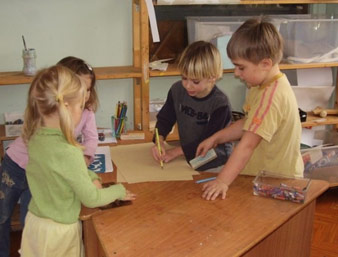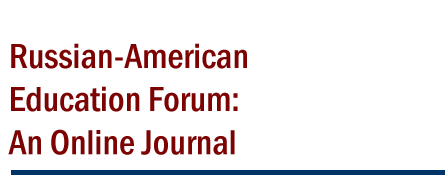

Volume:2, Issue: 2
Aug. 1, 2010


Aug. 1, 2010
DESCRIPTORS: early childhood education, educational programs, children, classical educational principles, organized and free activities for children, primary and additional programs, compound and specialized programs, types of preschools, a preschool oriented towards children’s development, a center for children’s development.
SYNOPSIS: The past twenty years of preschool education in Russia have been enriched with a number of different educational programs that should be based on classical educational principles. While choosing an educational program for a preschool, one should take into consideration its type, its primary objectives, and its own understanding of preschool activities. Several types of programs and preschools are described in the article.
Preschool Educational Programs – the Right to Choose
(abridged)1
Boyarintseva A.V.2
Due to a certain level of liberalization, the past twenty years of preschool education in Russia have been enriched with a number of different educational programs and methods, many of which are experimental, alternative, and authorial. This has given preschools an opportunity to freely choose their programs and at the same time has caused a number of interconnected problems.
Most importantly when we choose any educational program, we need to question who will benefit from its implementation. The only answer can be children. This is why we don’t believe in the absolute value of any program, regardless of how well developed and well structured it is. On the contrary, we trust any program that allows teachers to gently touch children’s personalities. In this respect, any program is interesting to us not as system of methods and strategies, or as a set of educational steps, but as a way to create flexible conditions for children’s and adults’ self-realization. Symbolically, a program should become a key, which unlocks a gate to the world of childhood, which helps to enrich it and to bring about and develop capacities of every preschool student.
We agree with the researchers who consider that any educational program should be based on classical educational principles:
We also agree that any program is supposed to help children in developing their common cognitive capabilities, their curiosity, and communication skills; any good program stimulates and encourages their creativity.
An educational program should have a number of different organized and free activities for preschoolers. It should also consider age and individual differences of different children and provide teachers with all necessary tools to preserve children’s health.
Now we will briefly describe various educational programs and our attitude towards them. Practically, all the programs can be divided into primary (1) and additional (2). Both can be authorial or/and optional. They are usually developed by teams of creative personalities or by individual authors.
1. Primary programs define all the main objectives and the primary contents of preschool activities. These programs can be divided further into compound (oriented towards general children’s development) and specialized (local):
One of the main demands is to provide smooth and logical succession of preschool programs with elementary school programs. Preschool programs should have indicators of children’s developmental levels for every age group throughout their preschool years.
2. Additional programs are usually programs for one or a few educational activities to provide children with some services (for an optional fee) which are not covered by primary educational programs and which are usually provided by clubs, studios, and sports facilities. These activities are more effective in the second part of the day. They cannot become a substitute for any primary program and they cannot be fulfilled during the time allocated for this program. Among the most interesting additional programs are the following: “A lively world of images,” “What color is the world,” “Creative labor,” “With a brush and music in my hand,” “Music folklore culture,” “A magic theatre world,” “A preschooler and economics,” etc.
In Russia today we do have some alternative preschools that operate on the basis of different foreign educators’ concepts (Maria Montessori preschools, or Waldorf preschools).
It is clear that while choosing an educational program for a preschool, we should take into consideration its type, its primary objectives, and its own understanding of preschool activities. The types of preschools are:
Let us briefly characterize some of these.
A preschool oriented towards children’s development usually exceeds the required curriculum in a particular area. Usually they use both, a compound program and an additional one.
A center for children’s developmentdoes exceed the required curriculum in a number of additional programs.
It is of utmost importance to remember that an educational program should meet the requirements of each preschool educational establishment. The most critical in this respect are the preschool goals and objectives; the program is just a way that helps to achieve them. Any program should be adapted to the specific preschool nature while teachers learn its ideas and methods. No one expects the direct implementation of any program. It makes more sense to try and actively adapt the program to the specific preschool character, to change and add any necessary components, to enrich the program with innovative methods, and to remodel it to meet the preschool objectives.
Finally, it is important to add that if the implementation of a certain program is difficult, and the teachers do not accept it, then it is hardly necessary to push them further or to pretend that it is working fine. A preschool educational process is always vibrant and individual, and we should respect and understand its demands. This situation should be thoroughly analyzed, the program should be removed and changed to another one which better meets the standards and principles of the preschool, and which is acceptable to the teachers. The best way to achieve success is to “grow” the cultural life of a preschool based on such programs and their components that allow the development of genuine communities of children and adults together.
1 Published with permission. Full text of this article was first published in the set of articles under the title “New Educational Values: Self-Being of Childhood”. Ed. Nata B. Krylova. – 3 (33). – 2007. Pp. 102-108.
2 Boyarintseva Anna V. [In Russian: Анна Викторовна Бояринцева], Ph.D., Senior Research Fellow, Institute of Psychological-Pedagogical Problems of Childhood, Russian Academy of Education.

Home | Copyright © 2025, Russian-American Education Forum